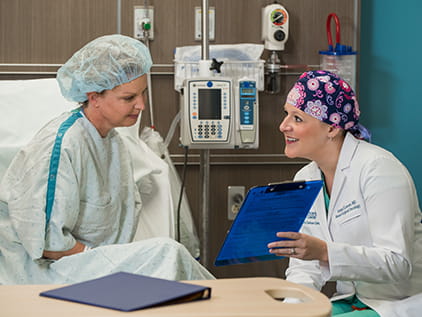- Home
- Conditions and Care
- Treatments
- Minimally Invasive and Robot-Assisted Surgery
- Minimally Invasive Head and Neck Surgery
Minimally Invasive Surgery
Minimally Invasive Head and Neck Surgery
Traditional head and neck surgery can treat a range of problems affecting the organs within the head and neck. The most common reason for head or neck surgery is to remove tumors and cancerous tissue, but thyroid problems and sinus disorders are also reasons that surgery could be necessary.
The surgeons at The University of Kansas Health System specialize in minimally invasive head and neck surgery using advanced techniques and instruments to reduce the risk and complications often associated with traditional surgery.
What is minimally invasive head and neck surgery?
Traditional surgical procedures used to treat diseases and disorders within the head and neck can result in scarring and disfigurement. The nature of open surgery also increases the risks and potential for complications that can arise whenever surgery is performed.
Robotic-assisted head and neck surgery reduces both the risks associated with surgery and the potential for scarring that may occur. The techniques used by surgeons during these minimally invasive procedures require only a few small incisions and also increase the precision with which a surgeon can perform an operation.
We offer a variety of appointment types. Learn more or call 913-588-1227 to schedule now.
Who can have minimally invasive head and neck surgery?
When medication and other nonsurgical treatments are not effective, surgery is the recommended treatment for conditions affecting the head and neck. Risks of traditional surgery can include pain, scarring and longer hospital stays and recovery times.
For common or complex conditions, robot-assisted surgery with the da Vinci® Robotic Surgical System may be the most effective and least invasive treatment choice. We are the only health system in Kansas City to offer single-port robot-assisted surgery, which uses only 1 incision. Our robotic surgeons perform many procedures of the head and neck, including:
- Base of tongue resection
- Radical tonsillectomy
- Supraglottic laryngectomy
How does minimally invasive head and neck surgery work?
Rather than open surgery, minimally invasive head and neck surgery uses only small incisions to insert tiny wire-like instruments that allow a surgeon to see and work directly in the target area.
These wires are called catheters and can be fitted with a variety of instruments ranging from cameras to lasers. Using this advanced surgical technology allows doctors to see tissue at a microscopic level and work on the body with the type of precision that greatly improves outcomes.
The da Vinci Surgical System’s high-definition 3D vision and magnified view provides even greater enhancement to a surgeon's capabilities. Robot-assisted surgery greatly enhances a doctor’s ability to see and make tiny, precise movements when performing head and neck surgery.

Cancer care you can count on
The University of Kansas Cancer Center is 1 of fewer than 60 NCI-designated comprehensive cancer centers in the nation, and it's part of The University of Kansas Health System.
Benefits and risks of minimally invasive head and neck surgery
All surgical procedures carry some risk. Bleeding, infection and complications with anesthesia and medication are potential concerns that every doctor addresses before the operation. Minimally invasive head and neck surgery reduces the potential for these risks.
For surgeons, the da Vinci allows greater precision and control than traditional methods. For patients, benefits can include:
- Faster return to normal speech and swallowing
- Fewer complications
- No tracheotomy
- No visible scarring or disfigurement
- Preservation of the larynx
- Reduced or eliminated need for chemoradiation therapy
- Reduced risk of larynx nerve damage
- Shorter hospital stays and recovery times
- Significantly reduced blood loss
You and your doctor will determine the best surgical options for your condition.
What happens during minimally invasive head and neck surgery?
Like most surgical procedures, an anesthetic or numbing agent is used to reduce pain and movement during the operation. Unlike open surgeries, which require large incisions, minimally invasive techniques rely on cameras and tiny instruments that are inserted into the body.
Minimally invasive techniques are particularly useful in head and neck surgery, where organs tend to be smaller and more delicate. The da Vinci’s 3D camera allows our surgeons to remove diseased tissue while preserving healthy tissue and normal functions of swallowing, breathing and voice.

Still the best
Our hospital continues to rank as the best in Kansas City and in Kansas according to U.S. News & World Report.

Magnet-recognized
The University of Kansas Hospital has been designated a Magnet® facility by the American Nurses Credentialing Center since 2006. 
Respect for all people
Named a leader in LGBTQ+ Healthcare Equality by the Human Rights Campaign. 



